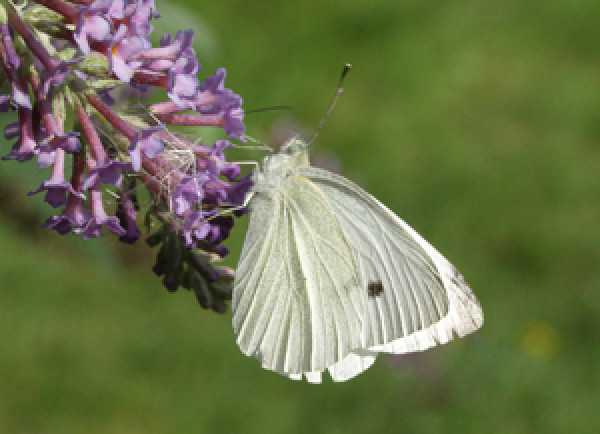Small White
Pieris rapae

The Small White is most likely to be confused with the Green-veined White (especially those poorly marked individuals of either species). The best way to separate the two species is to look at the dark tips to the upper surface of the forewings, and also to look for the dusting of scales along the veins (seen in Green-veined White). In Small White, these dark wing tips end abruptly and do not gradually merge into the darkened wing veins seen in Green-veined White. Large White, as its name suggests, is a larger butterfly and has more strongly marked wing tips. Individual Small Whites usually show two small black spots on the forewing (visible from above and below) and a single black spot on the upperside of the hindwing. First brood males often lack the spots on the upperside of the forewings. Second brood individuals of both sexes are typically more strongly marked. The pale green caterpillar has a fine yellow dorsal stripe and a series of yellow spots along its side.
Small Whites live in loose, open populations and can be found across a range of habitats. Females lay their eggs in the underside of leaves, usually (in gardens) on cultivated brassicas and nasturtiums. Each egg usually hatches within three to seven days ,and the resulting caterpillar then eats a small hole in the leaf before heading towards the heart of the plant. Here, it will remain hidden for a week or so, growing in size, before moving back to feed on the leaves of the plant, hiding along the leaf mid-rib to avoid predators. The caterpillars suffer from very high levels of predation when they are young, and up to two-thirds of those that hatch may be taken by predators like beetles and harvestmen.
Older caterpillars and chrysalises are often taken by birds, especially tits and warblers, and it has been found that Small Whites lack the range of toxins stored by Large Whites, something that is likely to have an influence on the level of predation. There are also parasites, notably the parasitic wasp Apanteles rubecula, and various viruses, the latter being important during cold, wet summers. There has been no notable change in the status of this species over the last few decades.






Share this page